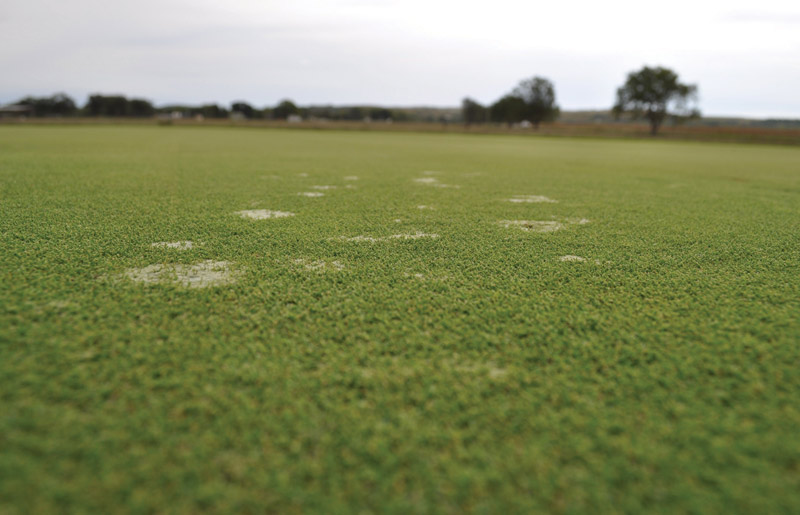
Current putting green cultural practices are encouraging the establishment and competitiveness of silvery-thread moss and hampering its prevention and control. Photo by Zane Raudenbush
Controlling and preventing the spread of silvery-thread moss (Bryum argenteum Hedw.) in golf course putting greens is a difficult task for several reasons. In recent decades, improvements in equipment technology, nutrient management strategies and putting green construction along with changes in golfer expectations have influenced the intensity and scope of cultural practices used by superintendents. It is likely that a number of these cultural practices are affecting the establishment and competitiveness of silvery-thread moss in putting greens (8, 14).
Silvery-thread moss also has several unique biological and ecological traits that create challenges for developing successful management strategies. In this article, we discuss how silvery-thread moss’s unique traits are interacting with putting green management practices, so golf course superintendents will be better equipped to develop successful, long-term management strategies.
Silvery-thread moss biology and dispersal
An established silvery-thread moss colony is comprised of individual shoots, protonema and rhizoids. The stems and leaves of silvery-thread moss are known as shoots. A colony of shoots is called a gametophyte. Shoots can form from structures produced during sexual or asexual reproduction. During the sexual cycle, spores are produced that contain genetic information from both male and female parents. Under favorable conditions, the spore germinates, giving rise to a mass of chloroplast-containing, threadlike green filaments called protonema, which can also be produced directly from shoots or bulbils. Protonema are capable of growing along the surface of almost any stable structure, but can easily desiccate if moisture is not available (10). This is perhaps the most vulnerable stage in silvery-thread moss’s life cycle.
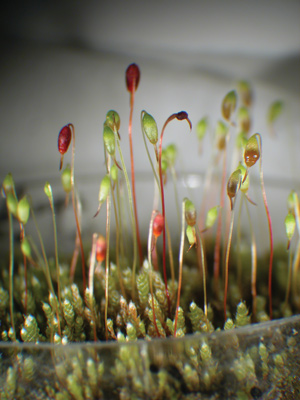
Right: Spores are produced inside the sporophyte, which is the small, headlike projection at the end of the stalk. This group of sporophytes was raised in a petri dish under laboratory conditions. Photo by Lloyd Stark
As protonema develop, buds are produced that give rise to an individual shoot, which differentiates into stems and leaves. Silvery-thread moss produces an extensive rhizoid system, enabling it to anchor to almost any substrate. The rhizoid resembles the roots of vascular plants, but silvery-thread moss rhizoids do not appear to have the ability to conduct water and nutrients internally (7).
While silvery-thread moss is capable of both sexual and asexual reproduction (4), the most advantageous mode of reproduction in putting greens is not clear. For instance, during sexual reproduction, spores are released from fruiting bodies at the top of a stalk, similarly to the seeds of a dandelion. Because putting greens are typically mowed daily, it is likely the stalks containing the spores are removed or simply crushed by the weight of the mower. Therefore, spore production is unlikely to be a viable mode of reproduction for established silvery-thread moss in a putting green. Spores may, however, play a role in the initial stages of invasion in a putting green that was previously uninhabited by silvery-thread moss.
Once established, silvery-thread moss can spread from several asexual structures, which likely serve as the primary mechanisms for increasing the size of an infestation (12). For instance, regeneration can occur from fragmentation or through the production of specialized organs, such as bulbils (6). Fragmentation is a simple form of vegetative reproduction, and it occurs when a shoot is separated from the gametophyte (6). Fragments are capable of traveling long distances, but they are typically deposited in close proximity to the original gametophyte. Once deposited in a favorable site, protonema radiate from the fragment, producing several hundred new shoots (6).
Bulbils are small, highly condensed leaves and may be produced in large quantities from stems of silvery-thread moss (12, 13). One to several can be produced per shoot (6). After they have been transported to a favorable site, bulbils “germinate” and produce new shoots or protonema.
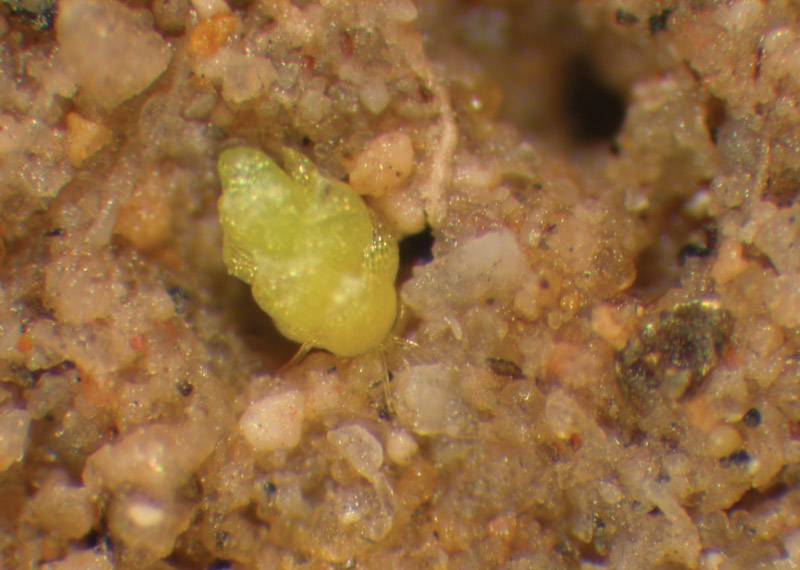
Bulbils are small, highly condensed leaves that may be produced in large quantities from stems of silvery-thread moss. Photo by Lloyd Stark
Shoot fragments and bulbils are buoyant and readily transported by water. A heavy rainfall or irrigation can therefore move vegetative structures to previously uninhabited areas (10). Propagules (bulbils, shoot fragments and protonemal fragments) can also be transported from green to green by adhering to golfers’ shoes or to maintenance equipment. Consequently, while sexual reproduction is likely important for long-distance dispersal of spores to previously uninhabited areas, researchers have suggested that movement of vegetative structures serves as the primary mode of short-distance dispersal (6, 12).
Water relations
Silvery-thread moss is nonvascular and therefore obtains minimal water and nutrients from the soil (7). Rather, it acts more like a sponge, absorbing water and nutrients directly into the gametophyte. Because of this unique adaptation, it has developed a complex method of surviving prolonged periods when water is lacking.
During periods of drought, silvery-thread moss will completely dehydrate and enter a dormant state, possibly for several years, but active growth will resume when water is no longer limiting. Amazingly, several metabolic pathways of silvery-thread moss can return to normal functioning within minutes of being rehydrated. However, in putting greens, silvery-thread moss typically receives enough water from rainfall or irrigation to remain active throughout most of the growing season.
Unfortunately, manipulating an irrigation schedule to encourage silvery-thread moss desiccation is impractical, especially in summer, when turfgrass roots recede and evapotranspiration rates are high. In addition, many courses strive for firm and fast conditions, so superintendents are often required to reduce the quantity of irrigation while increasing the frequency. This increased irrigation frequency has been shown to affect the establishment of silvery-thread moss.
For example, when irrigated pots containing ground silvery-thread moss shoots with either 75% or 100% Eo (open pan evaporation) were watered at one-, two-, four- or seven-day intervals, watering frequency did not affect the number of silvery-thread moss shoots produced (9). However, daily watering resulted in higher shoot counts. Superintendents struggling with silvery-thread moss should pay strict attention to their irrigation practices and, whenever possible, try to limit the number of irrigation events on moss-infested greens (see “Best management practices for silvery-thread moss,” below).
No published research has identified a connection between poorly drained putting greens and the establishment of silvery-thread moss, but a moist surface is likely to enhance the survival of dispersed propagules (fragments, bulbils, protonema) and established gametophytes. Superintendents should examine the putting green soil profile to determine whether excessive thatch or layering is reducing infiltration rates.
Best management practices for silvery-thread moss
- Reduce irrigation frequency to encourage desiccation of disseminated shoot fragments, bulbils and protonema.
- Implement a light and frequent topdressing program throughout the growing season.
- Reduce the frequency of soluble nitrogen applications; consider substituting slow/controlled-release nitrogen applications in spring.
- Applications of QuickSilver should be used in combination with cultural practices, as the herbicide is effective in reducing the size of infestations but does not usually lead to complete eradication.
- Increase air movement via fans or selective removal of surrounding vegetation to encourage light penetration and air circulation.
- Increase cutting heights.
- Address factors contributing to poor drainage and infiltration.
Mowing and topdressing
The factors primarily responsible for the dispersal of asexual silvery-thread moss propagules are currently unknown. Researchers have attributed the increased incidence of silvery-thread moss in putting greens to excessively low cutting heights (8). In Kansas, greater moss cover in a creeping bentgrass putting green was reported when plots were mowed at 0.125 inch (3.175 millimeters) compared with plots mowed at 0.157 inch (4 millimeters) (8).
Lower cutting heights can lead to stressed turfgrass plants, decreasing their competitiveness against weed species. Furthermore, the likelihood of the mower removing or dislodging individual shoots or bulbils increases as cutting heights decrease. Such fragments may then be dispersed around the green on equipment or golfers’ shoes.
By contrast, the thin layer of sand applied during routine topdressing is a management practice that may reduce silvery-thread moss. Turfgrass plants quickly grow through the layer of sand, but the vertical growth rate of silvery-thread moss is much slower in relation to turfgrass.
Research in Tennessee (2) reported four biweekly topdressing applications reduced silvery-thread moss cover by 34% in a creeping bentgrass putting green. This reduction may have occurred because topdressing elevated the effective height of cut in relation to the gametophyte, reducing the incidence of fragmentation caused by mowing, compared with a green that does not receive frequent topdressing. Furthermore, topdressing dilutes thatch, providing a firmer surface for the mower to ride on (5). If thatch is excessive, the mower will sink into the turf, lowering the effective height of cut and increasing the likelihood of the mower clipping silvery-thread moss shoots.
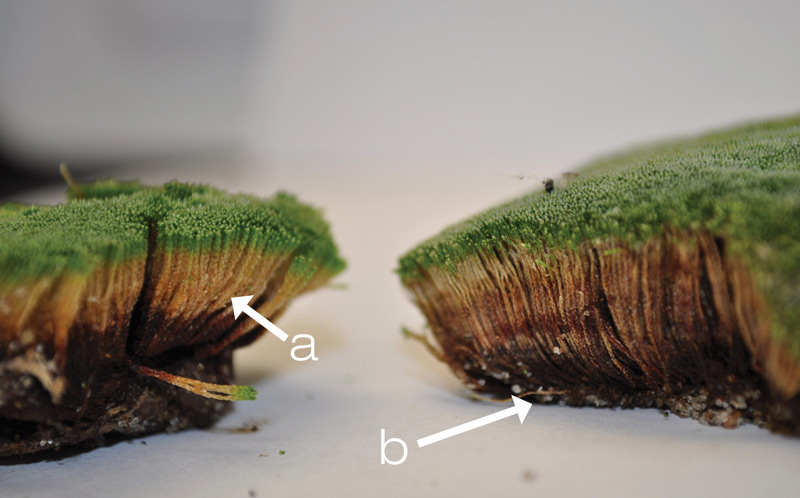
A silvery-thread moss gametophyte containing (a) gametophores and (b) rhizoid mat.
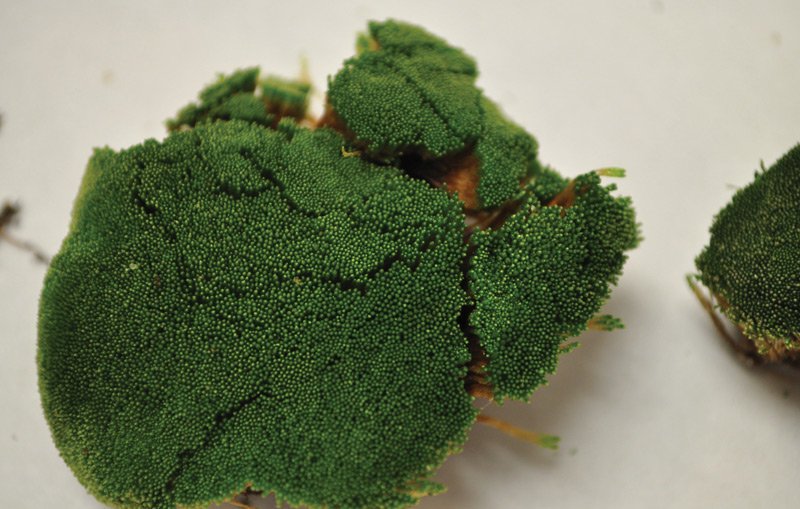
An overhead view of a gametophyte. Photos by Zane Raudenbush
Many of the current cultural practices, such as aerification, grooming, verticutting and brushing, are aimed at manipulating the turfgrass canopy and are likely affecting the fragmentation and dispersal of silvery-thread moss. Currently, the effects of these practices on silvery-thread moss establishment have not been evaluated, but this information would be helpful in managing existing infestations.
Nitrogen applications
Nitrogen fertilization is important for maintaining acceptable turfgrass quality. Superintendents typically spoon-feed nitrogen throughout the growing season for several reasons: 1) A single application of 1 to 2 pounds of nitrogen/1,000 square feet (4.8 to 9.7 grams/square meter) in summer can cause a flush of growth, leading to excessive thatch buildup and potentially leaving the canopy prone to scalping; 2) high nitrogen rates encourage some diseases; and 3) many superintendents apply preventive fungicides and plant growth regulators about every 14 days in summer, and soluble nitrogen fertilizers, such as urea and ammonium sulfate, are often included in the spray mixture at low rates (≤ 0.2 pound of nitrogen/1,000 square feet [0.97 gram/square meter]).
Spoon-feeding nitrogen likely increases the competitiveness of silvery-thread moss. For instance, researchers in Kansas sprayed urea at 0.3 pound of nitrogen/1,000 square feet (1.46 grams/square meter) biweekly throughout the growing season and reported a 47% increase in silvery-thread moss infestation (14). In another study, researchers sprayed urea and ammonium sulfate at 0.1 pound of nitrogen/1,000 square feet (0.48 gram/square meter) every week throughout the growing season and reported a twofold increase in silvery-thread moss cover (11).
For some, the benefits of spraying soluble nitrogen may outweigh the possibility of increasing the competitiveness of silvery-thread moss. Therefore, if superintendents with silvery-thread moss infestations spray soluble nitrogen, they should consider integrating practices that discourage moss growth, such as a herbicide application.
Chemical management
Several researchers have conducted studies on the current chemical control strategies for reducing silvery-thread moss in putting greens (1-3, 8, 14). All achieved some level of success, but none was effective at completely eradicating silvery-thread moss from putting greens. Arguably, the most effective control has been achieved with the herbicide QuickSilver (carfentrazone-ethyl, FMC Corp.), but control has been inconsistent and temporary (1, 2, 8, 14).
Carfentrazone-ethyl inhibits an enzyme (PPO) involved in the production of chlorophyll. Inhibition of PPO ultimately causes cell membranes to break down and their contents to leak out. Carfentrazone-ethyl inhibits PPO in the chloroplast, but the tips of B. argentum shoots are the only area that contains active chloroplasts. Therefore, the herbicide only injures the shoot tips, allowing for regrowth to occur from the lower segments of the shoots. Consequently, superintendents should not expect a single application of QuickSilver to completely eradicate a moss infestation. Nevertheless, QuickSilver is a valuable tool that can reduce the competitiveness of silvery-thread moss, providing an opportunity for desirable turfgrass species to crowd it out.
Superintendents should be aware of the conditions at the time of the herbicide application. Silvery-thread moss has the potential to be dormant if water is not present, which would likely reduce the efficacy of a herbicide application. Applying a small amount of irrigation before spraying QuickSilver will ensure the gametophytes are hydrated and active.
Promoting moss while managing turf
Current management practices on golf course putting greens, designed to deliver a firm, fast putting surface, appear to complement the ecology and biology of silvery-thread moss. Water is seldom limiting in many putting greens, allowing silvery-thread moss to remain active throughout most of the growing season. In putting greens where silvery-thread moss is prevalent, we recommend superintendents pay strict attention to water management practices. A higher irrigation frequency is likely to favor the establishment of deposited bulbils and fragments, leading to further infestation. Silvery-thread moss’s internal water content is directly related to its surrounding environment. Therefore, superintendents should increase air movement through the use of fans or selective removal of surrounding vegetation to encourage desiccation of asexual propagules and gametophytes.
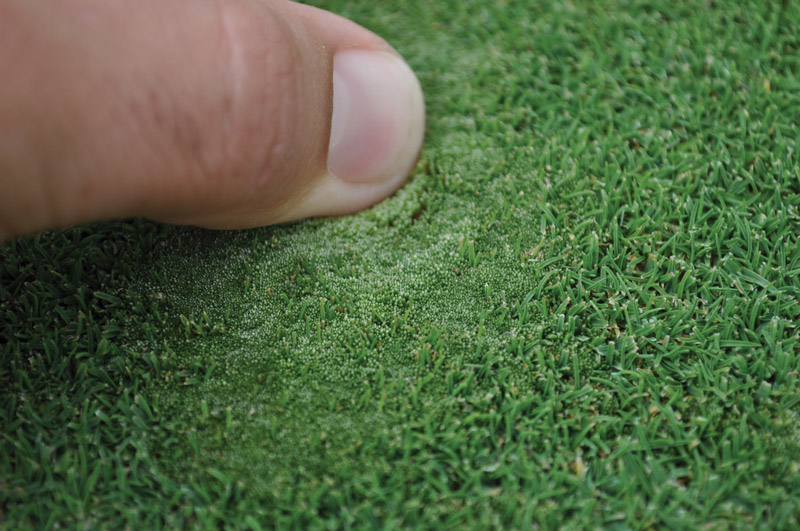
Silvery-thread moss is undesirable on putting greens because it can negatively affect ball roll and surface uniformity. Photo by Zane Raudenbush
Frequent applications of nitrogen appear to enhance the growth and competitiveness of silvery-thread moss in putting greens, but reducing fertility is not recommended as a means of control. Improper fertility can lead to increased incidence of several diseases and reduce the healing of ball marks, all of which create available sites for silvery-thread moss propagules to grow. Furthermore, a good fertility program is essential to producing an extensive root system, which should enable superintendents to decrease irrigation frequency. If superintendents who regularly spray soluble nitrogen experience an increase in moss, they should consider lengthening the interval between applications.
Frequent topdressing has been shown to reduce silvery-thread moss. Topdressing provides a firmer surface for the mower to ride on, decreasing the likelihood of the bedknife or reel coming in contact with the gametophyte, especially at low cutting heights. Topdressing sand is often brushed into the canopy to help reduce the amount of material picked up by the mowers. Research is not available regarding the effects of brushing/brooming on dispersal of silvery-thread moss propagules, but it is likely to physically dislodge vegetative propagules.
The importance of monitoring for silvery-thread moss cannot be overemphasized, because a colony 2 inches (5 centimeters) in diameter can contain thousands of individual shoots, each capable of establishing a new colony. Additionally, the ability of silvery-thread moss to retain and absorb water increases with the size of the colony. Individual shoots deposited away from the original colony are highly susceptible to desiccation. Furthermore, the efficacy of control measures is likely to be enhanced if an invasion of silvery-thread moss is caught early. Control may be much more difficult during the later stages of an infestation.
Conclusion
A magic bullet for selective control of silvery-thread moss does not seem likely in the near future, but management practices aimed at reducing the number of available propagules for dispersal, in conjunction with current control measures (see “Best management practices for silvery-thread moss,” above), are likely to keep populations low.
Lastly, from personal experience, superintendents typically battle with silvery-thread moss in select greens on the property. This begs the question: Why isn’t it a major problem on every green? Several factors could be to blame, but, ultimately, those affected greens likely contain a microenvironment that is optimal for silvery-thread moss. Superintendents should consider which factors are contributing to the success of silvery-thread moss on infested greens and address them in order to obtain successful long-term control.
Funding
We thank the Kansas GCSA and the Kansas Turfgrass Foundation for funding this research.
Acknowledgments
We thank Drs. Cole Thompson, Jack Fry and Megan Kennelly for their scholarly contributions to this work.
The information in this paper was originally published as “A review: Establishment, dispersal and management of silvery-thread moss (Bryum argenteum Hedw.) in putting greens” by Z. Raudenbush, S.J. Keeley and L.R. Stark in the online journal Forage, Crop & Turfgrass Management (May 13, 2015; doi:10.2134/cftm2014.0094). The content in this article was used by permission of the Crop Science Society of America Inc., Madison, Wis., USA.
The research says ...
- Silvery-thread moss is difficult to prevent and control.
- Movement of vegetative structures of silvery-thread moss on golfers’ shoes and on mowing equipment is likely the primary means of short-distance dispersal.
- Encouraging desiccation of silvery-thread moss on a golf course is impractical. Because daily watering encourages silvery-thread moss, irrigation frequency should be reduced on infested greens.
- Because spoon-feeding nitrogen likely increases the competitiveness of silvery-thread moss, superintendents should integrate practices that discourage moss growth, such as a herbicide application.
- Frequent topdressing and higher mowing heights appear to reduce silvery-thread moss.
- Monitoring for silvery-thread moss cannot be overemphasized. Efficacy of control measures is likely to be enhanced if silvery-thread moss is caught early.
Literature cited
- Boesch, B.P., and N.A. Mitkowski. 2005. Chemical methods of moss control on golf course putting greens. Online. Applied Turfgrass Science doi:10.1094/ATS-2005-1006-01-RV.
- Borst, S.M., J.S. McElroy and G.K. Breeden. 2010. Silvery-thread moss control in creeping bentgrass putting greens with mancozeb plus copper hydroxide and carfentrazone applied in conjunction with cultural practices. HortTechnology 20(3):574-578.
- Burnell, K.D., F.H. Yelverton, J.C. Neal et al. 2004. Control of silvery-thread moss (Bryum argenteum Hedw.) in creeping bentgrass (Agrostis palustris Huds.) putting greens. Weed Technology 18(3):560-565.
- Crum, H.A., and L.E. Anderson. 1981. Mosses of Eastern North America. Two volumes. Columbia University Press, New York.
- Dernoeden, P.H. 2013. Creeping Bentgrass Management, 2nd edition. CRC Press, Boca Raton, Fla.
- Frey, W., and H. Kürschner. 2011. Asexual reproduction, habitat colonization and habitat maintenance in bryophytes. Flora 206:173-184.
- Glime, J.M. 2007. Bryophyte Ecology. Volume 1. Physiology Ecology. Online. E-book sponsored by Michigan Technical University and the International Association of Bryologists. (www.bryoecol.mtu.edu). Accessed Aug. 27, 2015.
- Kennelly, M.M., T.C. Todd, D.M. Settle and J.D. Fry. 2010. Moss control on creeping bentgrass greens with standard and alternative approaches. HortScience 45(4):654-659.
- Lyons, E.M., K.S. Jordan, I.T. James et al. 2012. Irrigation frequency influences the establishment of silvery thread moss (Bryum argenteum Hedw.) and rooting of creeping bentgrass (Agrostis stolonifera L.) on simulated golf greens. Acta Agriculturae Scandinavica, Section B — Soil & Plant Science 62:79-85.
- Proctor, M.C.F., M.J. Oliver, A.J. Wood et al. 2007. Desiccation tolerance in bryophytes: a review. The Bryologist 110(4):595-621.
- Raudenbush, Z., and S. Keeley. 2015. Effect of nitrogen source and spray volume on the establishment and colonization of silvery-thread moss (Bryum argenteum Hedw.) in putting greens. Online. Crop, Forage & Turfgrass Management doi:10.2134/cftm2015.0145.
- Selkirk, P.M., M.L. Skotnicki, J.A. Ninham et al. 1998. Genetic variation and dispersal of Bryum argenteum and Hennediella meimii populations in the Garwood Valley, Southern Victoria Land, Antarctica. Antarctic Science 10:423-430.
- Stark, L.R., N.D. McLetchie and S.M. Eppley. 2010. Sex ratios and the shy male hypothesis in the moss Bryum argenteum (Bryaceae). The Bryologist 113(4):788-797.
- Thompson, C., M. Kennelly and J. Fry. 2011. Effect of nitrogen source on silvery-thread moss on a creeping bentgrass putting green. Online. Applied Turfgrass Science doi:10.1094/ATS-2011-1018-02-RS.
Zane Raudenbush undertook this research as a Ph.D. student in the Department of Horticulture, Forestry, and Recreation Resources at Kansas State University, Manhattan, Kan., and completed his Ph.D. in May 2015. Steven J. Keeley is a professor in the Department of Horticulture, Forestry, and Recreation Resources at Kansas State University, Manhattan, Kan. Lloyd R. Stark is an associate professor in the School of Life Sciences at the University of Nevada, Las Vegas.